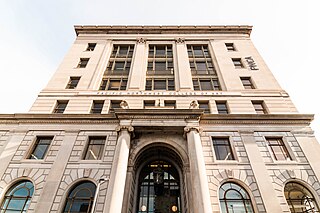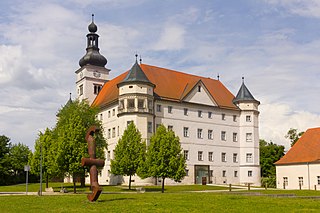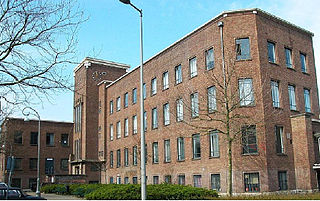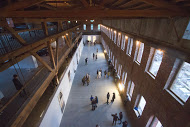
Linz is the capital of Upper Austria and third-largest city in Austria. Sitting on the river Danube, the city is located in the far north of Austria, 30 km (19 mi) south of the border with the Czech Republic. In 2018, the city had a population of 204,846 within its administrative urban area.

The Ikon Gallery is an English gallery of contemporary art, located in Brindleyplace, Birmingham. It is housed in the Grade II listed, neo-gothic former Oozells Street Board School, designed by John Henry Chamberlain in 1877.

The Pacific Northwest College of Art (PNCA) is an art school of Willamette University and is located in Portland, Oregon. Established in 1909, the art school grants Bachelor of Fine Arts degrees and graduate degrees including the Master of Fine Arts (MFA) and Master of Arts (MA) degrees. It has an enrollment of about 500 students. The college merged with Willamette University in 2021.

Schloss Hartheim, also known as Hartheim Castle, is a castle at Alkoven in Upper Austria, some 14 kilometres (9 mi) from Linz, Austria. It was built by Jakob von Aspen in 1600, and it is a prominent Renaissance castle in the country.

The DeCordova Sculpture Park and Museum is a sculpture park and contemporary art museum on the southern shore of Flint's Pond in Lincoln, Massachusetts, 20 miles northwest of Boston. It was established in 1950, and is the largest park of its kind in New England, encompassing 30 acres.
AS220 is a non-profit community arts center located in Downtown, Providence, Rhode Island, United States. AS220 maintains four dozen artist live/work studios, around a dozen individual work studios, six rotating exhibition spaces, a main stage, a black box theater, a dance studio, a print shop, a community darkroom, a digital media lab, a fabrication lab, an organization-run bar and restaurant, a youth recording studio, and a youth program. AS220 is an unjuried and uncensored forum for the arts, open to all ages.

The Knoxville Museum of Art (KMA), is an art museum in Knoxville, Tennessee. It specializes in historical and contemporary art pieces from the East Tennessee region. According to its mission statement, the museum "celebrates the art and artists of East Tennessee, presents new art and new ideas, educates and serves a diverse community, enhances Knoxville’s quality of life, and operates ethically, responsibly, and transparently as a public trust."

The Power Plant Contemporary Art Gallery is a Canadian public art gallery located at Harbourfront Centre in the heart of Toronto, Ontario, Canada. The Gallery is a registered Canadian charitable organization. supported by its members, sponsors, and donors, including funding authorities at all levels of government.

Burlington City Arts is an art gallery, art education/studio centre and cultural events space in Burlington, Vermont. The building was originally built as the Ethan Allen Firehouse on Church Street in 1889. The building is owned by the City of Burlington. Burlington City Arts uses the building for its exhibits, lectures, and educational programs. The gallery has been open since 1995.

The Stadtwerkstatt is an open event and project house in Linz. Founded in 1979 by young activists, it is the city's oldest autonomous cultural center. In addition to several music events each week, other cultural and artistic events are also held regularly. Three different associations operate in the Stadtwerkstatt building: the Friedhofstr 6 association with its Cafe Strom, art projects and events departments, as well as the non-commercial radio station Radio FRO and the net art and culture initiative servus.at.

The Master Apartments, officially known as the Master Building, is a 27-story Art Deco skyscraper at 310 Riverside Drive, on the Upper West Side of Manhattan, New York City. It sits on the northeast corner of Riverside Drive and West 103rd Street. Designed by Harvey Wiley Corbett of the firm Helmle, Corbett & Harrison, in conjunction with Sugarman & Berger, the Master Apartments was completed in 1929 as the tallest building on Riverside Drive. It was the first skyscraper in New York City to feature corner windows and the first to employ brick in varying colors for its entire exterior.

Culture Factory Polymer was a multidisciplinary centre for artistic creation and diffusion in Tallinn, Estonia. Located in Lilleküla, Kristiine District, on the fringes of the Tallinn city centre, this former toy factory became in 2003 one of the main strong points for alternative un-institutionalized culture in Tallinn.

SMART Project Space was a publicly funded foundation for Contemporary Art founded in 1994 by the innovative cultural mediator Thomas Peutz. SPS closed its innovative exhibition programme in 2013, but remains a creative industries incubator, offering studio space to artists currently under the remit of SMART Estate Incorporation. Located in the old west of Amsterdam, SMART Project Space was a pioneering institution. It put the artist at the core of its programmes and sought stimulating and new relationships between the artist and the wider community. SMART commissioned, produced, and showcased some 70 contemporary visual art exhibitions, hosted hundreds of films, music and performance events, drawing together a wide range of creative approaches across disciplines.

The Kunsthaus Bregenz (KUB) presents temporary exhibitions of international contemporary art in Bregenz, Vorarlberg (Austria).

Belvedere 21, formerly 21er Haus or Einundzwanziger Haus, is a modernist style steel and glass building designed by Austrian architect Karl Schwanzer (1918–1975). Originally constructed as the Austrian pavilion or temporary showroom for the Expo 58 in Brussels, it was later transferred to Vienna to house the Museum of the 20th Century, which explains why it was first nicknamed "20er Haus". Between 1979 and 2001, the building also acted as a depository for contemporary art works. From 2009 to 2011, it was remodeled by the architect Adolf Krischanitz and consequently renamed 21er Haus to reflect the 21st century. It was renamed Belvedere 21 in 2018.

Pioneer Works is a non-profit cultural center in Red Hook, New York City. The center builds community through the arts and sciences to create an open and inspired world. It encourages radical thinking across disciplines by providing practitioners a space to work, tools to create, and a platform to exchange ideas that are free and open to all. 85% of its funds are spent on free programming.
Eva Pel is a Dutch visual artist living and working in Amsterdam.

Ars Electronica Linz GmbH is an Austrian cultural, educational and scientific institute active in the field of new media art, founded in Linz in 1979. It is based at the Ars Electronica Center (AEC), which houses the Museum of the Future, in the city of Linz. Ars Electronica's activities focus on the interlinkages between art, technology and society. It runs an annual festival, and manages a multidisciplinary media arts R&D facility known as the Futurelab. It also confers the Prix Ars Electronica awards.

Richard Randall Art Studio is a heritage-listed studio at Brisbane Botanic Gardens, Mt Coot-tha Road, Toowong, City of Brisbane, Queensland, Australia. It was built in c.1900. It is also known as Richard Randall's Studio. It was added to the Queensland Heritage Register on 21 October 1992.
Gudrun Baudisch, later Gudrun Baudisch-Wittke was an Austrian ceramist, sculptor and painter. Baudisch founded the Keramik Hallstatt workshop.



















